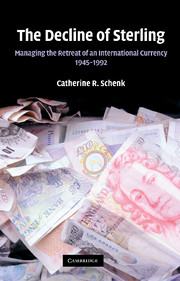Book contents
- Frontmatter
- Contents
- List of figures
- List of tables
- Acknowledgements
- 1 Introduction
- Part I Reconstructing the International Monetary System 1945–1959
- 2 The post-war international monetary system 1945–1950
- 3 The return to convertibility 1950–1959
- Part II Accelerating the Retreat: Sterling in the 1960s
- Part III Sterling's Final Retreat 1970–1992
- Index
2 - The post-war international monetary system 1945–1950
Published online by Cambridge University Press: 04 May 2010
- Frontmatter
- Contents
- List of figures
- List of tables
- Acknowledgements
- 1 Introduction
- Part I Reconstructing the International Monetary System 1945–1959
- 2 The post-war international monetary system 1945–1950
- 3 The return to convertibility 1950–1959
- Part II Accelerating the Retreat: Sterling in the 1960s
- Part III Sterling's Final Retreat 1970–1992
- Index
Summary
Much of the terminology and discourse relating to sterling throughout the post-war period was forged during the crisis years of the 1940s. The ‘overhang’ of overseas sterling liabilities over assets was clearly identified in wartime planning to reconstruct the international economy once hostilities had ended. The high profile that Britain's wartime debts developed in the public and government psyche in the 1940s made it difficult to recognise that the international use of sterling in the 1950s was fundamentally different from that in the immediate post-war period. They were not referred to as ‘war debts’ but, rather ambiguously, as sterling balances, partly no doubt because of the bitter memories of the interwar war debt debacle and the agreement between the United States and the United Kingdom in 1941 not to burden another peace with such a network of liabilities. Nevertheless, Britain had offered these government securities in part-payment for wartime expenditure. As a result, there is a surprising continuity in the identification of sterling's weaknesses from the 1940s through to the 1970s, despite fundamental changes both in the international monetary system in which sterling operated and in the distribution of sterling holdings internationally. In these crucial years the post-war international monetary system was reformed after the failed attempt at sterling convertibility in 1947 postponed global multilateralism for a further eleven years. The exchange controls imposed subsequently in 1947 established the legal framework for the post-war sterling area.
- Type
- Chapter
- Information
- The Decline of SterlingManaging the Retreat of an International Currency, 1945–1992, pp. 37 - 82Publisher: Cambridge University PressPrint publication year: 2010



